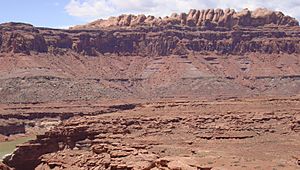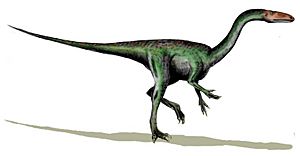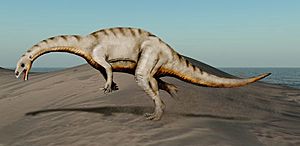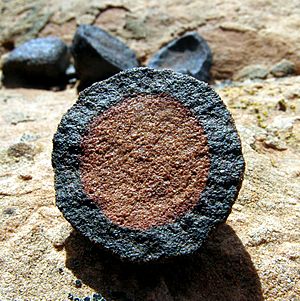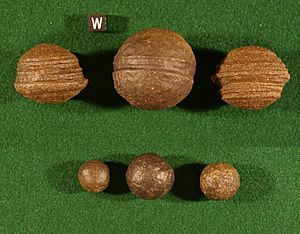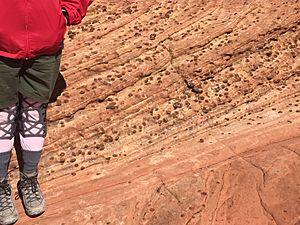Navajo Sandstone facts for kids
Quick facts for kids Navajo SandstoneStratigraphic range: Hettangian-Sinemurian ~200–195Ma |
|
|---|---|
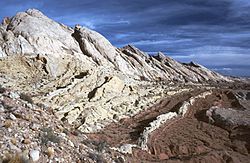
A prominent cuesta of Navajo Sandstone rims the edge of the San Rafael Swell in eastern Utah
|
|
| Type | Geological formation |
| Unit of | Glen Canyon Group |
| Underlies | Carmel Formation and Page and Temple Cap sandstones, separated by J-1 and J-2 unconformities |
| Overlies | Kayenta Formation with conformable and interfingering contact |
| Thickness | Up to 2,300 ft (700 m) |
| Lithology | |
| Primary | Eolian sandstone |
| Other | Lacustrine limestone and dolomite |
| Location | |
| Coordinates | 36°42′N 110°48′W / 36.7°N 110.8°W |
| Approximate paleocoordinates | 23°54′N 48°30′W / 23.9°N 48.5°W |
| Region | Arizona, Colorado, Nevada, Utah |
| Country | United States of America |
| Extent | 102,300 sq mi (264,955.8 km2) - original extent of the Navajo Sand Sea may have been 2.5 times larger than this remaining outcrop |
| Type section | |
| Named for | Navajo County |
| Named by | Gregory and Stone |
| Year defined | 1917 |
The Navajo Sandstone is a special type of rock layer. It is part of the Glen Canyon Group of rocks. You can find it across the United States in southern Nevada, northern Arizona, northwest Colorado, and Utah. It forms a big part of the Colorado Plateau region.
Contents
Navajo Sandstone is very famous in southern Utah. It creates amazing sights in many national parks. These include Zion National Park, Capitol Reef National Park, and Canyonlands National Park. It also forms parts of Red Rock Canyon National Conservation Area and Glen Canyon National Recreation Area.
This sandstone often sits on top of the Kayenta Formation. Together, these rock layers can form huge cliffs. These cliffs can be as tall as 2,200 feet (670 m). At the top, the Navajo Sandstone often looks like giant rounded domes. These domes are usually white.
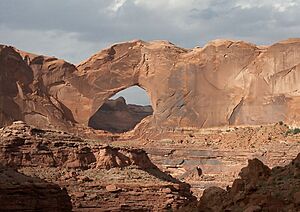
Navajo Sandstone often forms impressive cliffs, domes, and hills. You can tell it apart from other sandstones by its color. It is usually white to light pink. It also has unique rounded shapes from weathering.
The many colors of Navajo Sandstone show its long history. Over 190 million years, groundwater and other fluids changed it. The colors, except for white, come from tiny bits of hematite, goethite, and limonite. These are iron-based minerals that fill the spaces in the sand.
The iron in these rocks came from older iron-rich silicate minerals. This iron slowly coated the sand grains after they were laid down. Later, the sand was buried deep underground. Water mixed with hydrocarbons (like oil or gas) flowed through it. This liquid dissolved the iron coatings. This process turned large areas of the sandstone a bright white.
The dissolved iron then traveled with the water. When this iron-rich water met oxygen-rich groundwater, the iron settled out. It formed new minerals within the sandstone.
Different amounts and types of iron minerals created the many colors. These include black, brown, red, orange, pink, gold, and yellow. These iron minerals also formed harder layers and shapes. These shapes are more resistant to erosion. They stick out from the landscape as ledges, walls, and towers.
Scientists have studied the age of the Navajo Sandstone for a long time. It was named after the 'Navajo Country' in the southwestern United States. It does not have one specific place where it was first described.
In 1917, scientists Gregory and Stone first named it. Later, in 1936, Baker changed its classification. Its age was updated by Lewis and others in 1961. More recently, in 2019, a new study used Radiometric dating. This method measures how old rocks are. It showed that the Navajo Sandstone is entirely from the Jurassic period. It formed about 200 to 195 million years ago. This time period is known as the Hettangian to Sinemurian ages.
The sandstone formed in a very dry desert. This desert was a giant sand sea on the western part of the supercontinent Pangaea. This area had yearly monsoons. These were strong seasonal winds and rains that happened each winter.
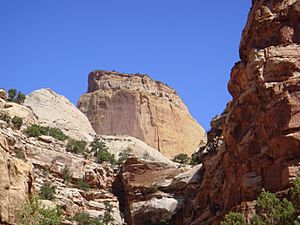
You can find Navajo Sandstone in many places. Here are some of the main areas:
It is also found in many national parks and monuments:
- Glen Canyon National Recreation Area
- Grand Staircase-Escalante National Monument
- Zion National Park
- Canyonlands National Park
- Capitol Reef National Park
- Arches National Park
- Colorado National Monument
- Pink coral sand dunes, Kanab, Utah
Scientists have found traces of ancient animals in the Navajo Sandstone. These include tracks and bones from ornithodires. Ornithodires are a group of animals that includes dinosaurs and pterosaurs.
| Ornithodires of the Navajo Sandstone | ||||||
|---|---|---|---|---|---|---|
| Genus | Species | Location | Material | Notes | Images | |
|
Ammosaurus cf. major |
|
|||||
|
D. wetherilli |
|
Tracks found at Red Fleet State Park. |
||||
|
Pteraichnus |
||||||
|
S. halli |
|
"Partial postcranial skeleton." |
||||
|
Seitaad |
S. ruessi |
|
||||
Moqui Marbles: Iron Balls in the Sandstone
The Navajo Sandstone is also famous for its many round iron balls. These are called "Moqui marbles." People who collect rocks love to find them. The name "Moqui" comes from the Hopi Native American language. It means "the dead," linking them to ancestor traditions.
Thousands of these marbles fall out of the Navajo Sandstone. You can find them in south-central and southeastern Utah. This area stretches from Zion National Park to Arches and Canyonlands national parks. They are very common in Grand Staircase-Escalante National Monument.
Moqui marbles come in many sizes and shapes. They can be perfectly round like peas or baseballs. Some are flat like buttons, or have spikes. Others are hollow tubes. Many are stuck together, but many more are found alone. Their surfaces can be rough or very smooth. Some even have grooves around them.
These marbles are made of sandstone cemented by hematite and goethite. These are iron oxide minerals. The iron came from older minerals that broke down. When the sandstone was buried, water with hydrocarbons dissolved this iron. Later, when this iron-rich water met oxygen-rich groundwater, the iron settled out. This created the many Moqui marbles. Some scientists think tiny living things might have helped form them too.
These Moqui marbles are like the "blueberries" found on Mars. The Opportunity rover found similar iron balls on the Martian surface.


